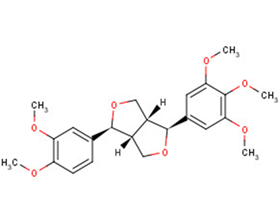
magnolin
CAS No. 31008-18-1
magnolin( —— )
Catalog No. M18406 CAS No. 31008-18-1
Magnolin reduces the renal oxidative stress, suppresses caspase-3 activity, and increases Bcl-2 expression in vivo and in vitro. Magnolin has anti-inflammatory and antioxidative effects.
Purity : >98% (HPLC)
 COA
COA
 Datasheet
Datasheet
 HNMR
HNMR
 HPLC
HPLC
 MSDS
MSDS
 Handing Instructions
Handing Instructions
| Size | Price / USD | Stock | Quantity |
| 10MG | 98 | In Stock |


|
| 25MG | 191 | In Stock |


|
| 100MG | Get Quote | In Stock |


|
| 200MG | Get Quote | In Stock |


|
| 500MG | Get Quote | In Stock |


|
| 1G | Get Quote | In Stock |


|
Biological Information
-
Product Namemagnolin
-
NoteResearch use only, not for human use.
-
Brief DescriptionMagnolin reduces the renal oxidative stress, suppresses caspase-3 activity, and increases Bcl-2 expression in vivo and in vitro. Magnolin has anti-inflammatory and antioxidative effects.
-
DescriptionMagnolin reduces the renal oxidative stress, suppresses caspase-3 activity, and increases Bcl-2 expression in vivo and in vitro. Magnolin has anti-inflammatory and antioxidative effects.
-
In Vitro——
-
In Vivo——
-
Synonyms——
-
PathwayOthers
-
TargetOther Targets
-
RecptorERK1| ERK2
-
Research AreaOthers-Field
-
Indication——
Chemical Information
-
CAS Number31008-18-1
-
Formula Weight416.47
-
Molecular FormulaC23H28O7
-
Purity>98% (HPLC)
-
SolubilityDMSO : 125 mg/mL 300.15 mM
-
SMILESO1[C@@H]([C@@H]2[C@H](C1)[C@H](OC2)c1cc(c(c(c1)OC)OC)OC)c1cc(c(cc1)OC)OC
-
Chemical Name——
Shipping & Storage Information
-
Storage(-20℃)
-
ShippingWith Ice Pack
-
Stability≥ 2 years
Reference
1. Wang F,et al. Magnolin protects against contrast-induced nephropathy in rats via antioxidation and antiapoptosis. Oxid Med Cell Longev. 2014;2014:203458.
molnova catalog



related products
-
Dehydrozingerone
Dehydrozingerone is a naturally occurring molecule. Dehydrozingerone is a versatile compound that has been extensively studied for its various biochemical and physiological effects.
-
Methylarbutin
Methylarbutin is an ice recrystallization inhibitor (IRI).
-
SAR348830
SAR348830 is novel potent and selective inhibitor of anaplastic lymphoma kinase (ALK).



 Cart
Cart
 sales@molnova.com
sales@molnova.com


